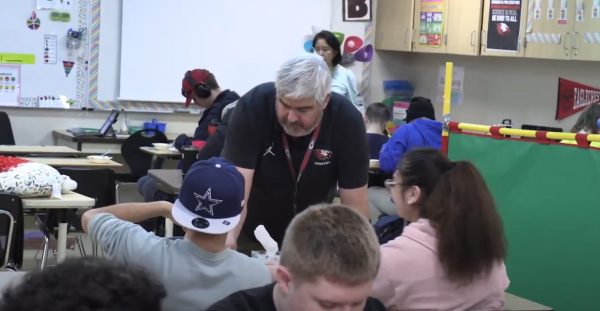“Can You Draw Me?”
An in-depth look at the stereotypes of an “art kid” –and how A.P. Studio Drawing students are tearing that down.
Walking into the Eaglecrest A.P. Studio Art classroom is unlike any walking into any other class in the building. Nineteen kids clustered around their various tables, supplies and artwork, which consumes nearly every inch of the room. Former and current artwork fill the walls — even some of the ceiling tiles are painted. There is no mistaking it; this is the art room. And during 3A, it’s filled with the self-proclaimed “art kids”.
“I think having access to the art room is awesome,” said Wren Allen. “It’s a nice space to be in. It’s a lot more welcoming than other places.” An A.P. Studio Drawing student, Allen has spent a considerable amount of time in the art room through his four years at Eaglecrest. And like most of the A.P. art students, he considers himself an unabashed “art kid”. A term burdened by a lengthy history of stereotypes, the art kids themselves have their own definitions of the phrase.
“An art kid is someone who prioritizes art and really just tries to express themselves through art. They’re really genuine people, and really unapologetic in their self-expression,” said Emma Fertig, a senior. Jordan Novak, another A.P. art student, also emphasized the idea of unapologetic self-expression.

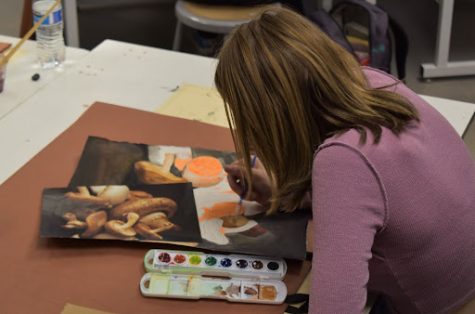
“You can tell in just our schoolwork. In our writing and how we do our math, how we take notes, you can just kind of tell the difference between someone who’s just at school or someone who is creative,” said Novak. She also noted how as an art kid, she is also more attuned to others’ self-expression. “What people wear, how people dress, how they walk, how they move: it’s just more poetic.” When immersed in art, one can see it everywhere. Part of that comes from being more interpretive and open to subjectivity, explained Gian-Lorenzo Zordani.
“They follow a stereotype, and yet every each one of them is very different, very unique,” said Zordani of the art kids. “I think it’s safe to say that most art kids are the most conspicuous. They’re very creative with how they present themselves too –very individualistic.” Individualism is key to artistic expression, and A.P. Studio Drawing teacher Lisa Adams is sure to encourage that in her students, pushing for original ideas and creative freedom alongside teaching techniques.
“Making art is also not about just the physical act. It’s also what goes on in your mind,” said Adams. Thus, creativity is inherently individualistic. Yet the “art kid” stereotypes run strong, perpetuated by media and all too present in real life. The most prevalent?
“It’s kind of portrayed that art kids just always have paint on them. Yeah, like everywhere. Just paint on everything,” said Allen. Paint isn’t the only medium these students work with, though. So to present art as primarily painting limits the definition of art –which can be created from a vast array of mediums, limited only by one’s imagination– and the art kids themselves.
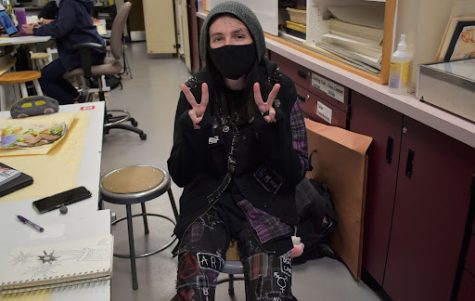
Allen explained another stereotype: that all art kids can draw people. Allen says this is not true for himself; though a talented artist, human figures and faces are simply not his style. Zordani, on the other hand, has a knack for drawing people, but even he describes how tiring it can be when the first question people ask him is the predictable, ‘Can you draw me?’
“They keep asking you to draw,” said Zordani. “That, or people just always say, ‘Oh, I wish I could draw’ or ‘imagine that would be me.’ Like, it could be. It’s not like I was born in it. I just keep doing it.” Often, art kids are reduced, whether intentionally or not, to their ability to make art, a fact which can be frustrating to many.
“It makes it feel like it’s like their one identity,” said Ellie Hull, a senior who has been in A.P. Art since last year. “Which it’s not, because I’m also a writer, and I also do tech theater. So I have other aspects of art that I like doing.” In media, art kids tend to remain fairly flat characters, with art taking up their entire lives. And in the media, if they’re not doing art, they’re not an art kid.
“I think the assumption that you’re always doing art is kind of sucky. Because sometimes, you know, you’re just not doing art,” said Allen. “You’re still an art kid. You’re just not actively working on a piece.” Art is about expression, but sometimes, even that raises questions and complications.
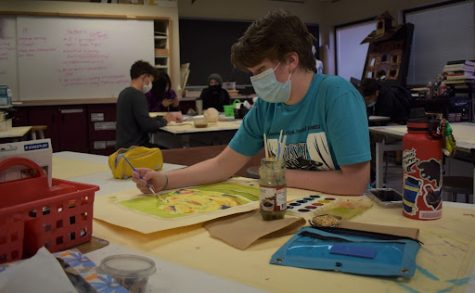
“That’s probably one of the biggest struggles as an art kid: ‘Am I truly expressing myself the way that I want to express and then be perceived as well?’” No matter how an art kid chooses to expresses themself, meaningful art cannot occur without feelings and experiences to express.
“Your experiences are also part of what’s gonna inform your art. And you have to have experiences,” explained Adams. Since every person’s experience is different, their personality and expression through art will also be different. This goes in direct contrast to media portrayals, of course.
“I think it’s sort of romanticized, like with the paint brushes in the back pocket. Like that’s not how kids actually are. I think it’s a lot messier and a lot more real,” said Fertig. Tess Rosen, a fellow classmate, has picked up on the complete opposite stereotype.
“I feel like they’re always depicted as a super like, brooding and miserable and super philosophical,” said Rosen. “But mostly we just kind of do the art. I don’t think it requires you to be super edgy.”
“Most art kids are just either super edgy or like super bubbly, which is not what all of us are like,” explained Hull. Novak describes that often, the art kid is either “the cool art kid” –treated well and adopted by the popular kids– or “the weird art kid” –more isolated, quiet, and relegated to the sidelines and shadows.
“There’s a lot of correlation between art and mental health in the media, especially,” said Novak. “Because I feel like it’s a lot of the only way people can let it out without being shamed.” One stereotype of art kids, however, remains true. For many of these self-proclaimed art kids, expression is paramount.
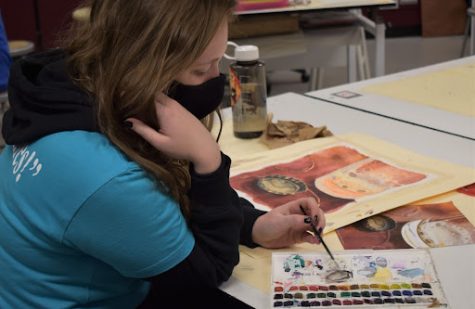
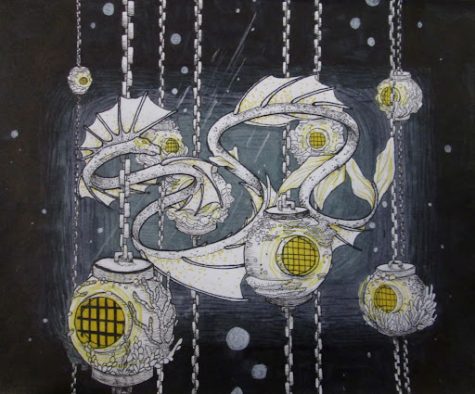
“The best part is getting to express your creativity in like a safe space,” said Hull. “With art, you just kind of get to do it in the medium you want to; you get to kind of choose what you make and how you express yourself.” And there is undoubtedly power in that kind of self-expression and communication.
“I think art is inherently just a language. So having that sort of avenue open to you and also to learn more about it and how to be good at it, I think is really fulfilling,” said Rosen. Art is a unique form of communication. Like a language, it can be used to communicate. Unlike most languages, however, it can reach across cultures and customs, expressing visually what cannot be expressed verbally. For the artists themselves, the process itself can be fulfillment enough, but sometimes, it takes another perspective to truly appreciate a piece.
“It’s always seeing the results you yourself made and feeling of satisfaction once you’re done with a project –or just people being able to see your art and relating to it,” said Zordani. He explains this by telling the story of an art piece of his that was put in the art show last year. “I didn’t think much of it; it was very boring for me. But a kid left a review of what he thought of it and actually changed the way I looked at this picture.” Viewers formulate their own interpretation of artwork, allowing pieces to take on a unique meaning for every person –which gives a certain kind of power and depth to the artist. Yet, as every art kid will tell you, artwork holds a special meaning for the artist themself.
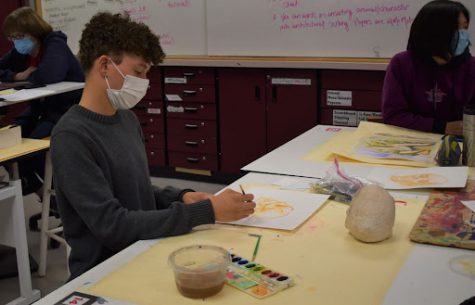

“I’ve been making art for the longest time. It’s the thing I’m most passionate about because even if I call myself a theater kid, I’m calling myself an art theater kid,” said Hull. “The place where I found my happiness is in an art room with a pencil in my hand….we put our hearts and our soul and sweat and tears into our art pieces.” That hard work and depth of individuality is what makes an art kid more than the stereotypes they experience.
“I think those stereotypes only matter to people who aren’t actually art kids. If you look at this class, there’s so many different types of kids, but we all have so much in common,” noted Fertig. “We all just love to express ourselves and we all just love to create.”
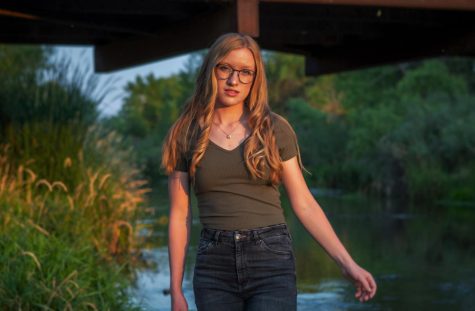
Simone Beauchamp is a Senior at Eaglecrest and, as she will let you know, she graduated from Challenge Middle School. She has many talents - photography,...


